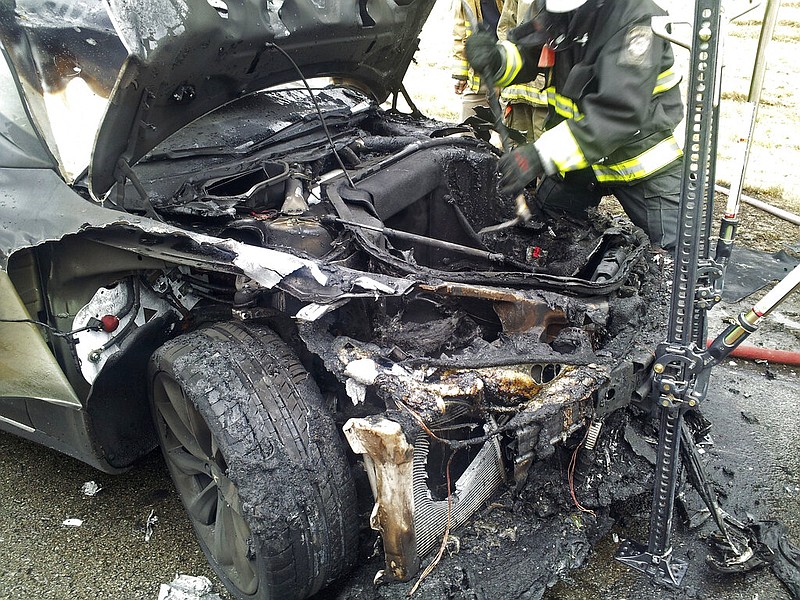ROGERS -- The Fire Department is on a mission to find the best ways to fight electric vehicle fires, according to Rogers Fire Chief Tom Jenkins.
Though such fires haven't yet become a problem in the city, they are a concern with more parking garages and more electric vehicles in Northwest Arkansas, Jenkins said.
One new method the department will use to address the fires is the use of suppression blankets, which would be stretched over the vehicle to limit the oxygen reaching the fire.
The City Council in July approved spending $15,000 for eight fire suppression blankets for the department.
The blankets won't entirely extinguish an electric vehicle fire on their own, but will be one of many tools the department will use, Jenkins said.
The department is also experimenting with fashioning a specialty nozzle, which could help water reach the lithium-ion battery underneath the car.
In addition, the department plans to respond with two fire engines rather than one to the site of each electric vehicle fire, he said. Fire engine tanks typically store between 500 and 1,000 gallons of water, enough to put out a fiery vehicle with an internal combustion engine, according to Jenkins.
Electric vehicle fires require the equivalent of a swimming pool, more water than a truck is able to carry, he said. About 3,000 to 8,000 gallons of water need to be applied directly to the battery to fully extinguish and cool a battery fire, according to the Emergency Response Guide for Tesla Model S.
In the guide for first responders, Tesla, a manufacturer of electric vehicles, states battery fires can take 24 hours to fully cool. Fire, smoke, heating and audible popping must be absent from the battery for 45 minutes before fire crews leave the vehicle, according to the electric vehicle manufacturer.
Water is the best method for controlling a battery fire, and finding large, sustainable water supplies of at least 3,000 to 8,000 gallons is recommended, according to the International Fire Chiefs Association.
"Fighting vehicle fires is inherently dangerous," a 2021 association bulletin on the subject stated. "When responding to an electric or hybrid vehicle fire there are additional challenges responding crews must consider."
A primary safety concern with lithium-ion batteries is thermal runaway, according to Jenkins. Thermal runaway is a process caused by cell defects or mechanical damage that can lead to "an uncontrollable, self-heating state," according to independent safety science organization UL Research Institutes. The phenomenon can lead to extremely high temperatures, smoke, fire and ejection of gas or shrapnel, according to the organization.
Any vehicle with a lithium-ion battery pack -- including e-bikes and electric scooters -- would present similar challenges, Jenkins said.
"It's a totally different game," he said. "Across the country, I'd say it's a lot of trial and error. It's not unique to Rogers."
Some fire departments in Europe are using cranes to lift flaming cars and submerge them in water, he said.
According to the U.S. Department of Energy, 2,390 all-electric vehicles were registered in Arkansas in 2021, an increase of about 1,500 since 2019. The number of electric vehicles in the U.S. nearly doubled in those two years, according to the federal department.
As the region sees an increased number of electric vehicles, the issue is on the minds of many fire departments. The topic came up at a recent meeting of Northwest Arkansas fire department leaders, according to Jenkins.
Springdale Fire Chief Blake Holte said his department has considered specialty nozzles, but hasn't purchased any new equipment to deal with electric vehicle fires. The department hasn't yet had to deal with the issue as much as other departments, he said.
Bentonville's department ordered a $320,000 quick response unit vehicle over a month ago, the result of a risk analysis of the issue, according to Deputy Chief Kevin Boydston.
"Our primary concern is an EV fire in a parking deck," Boydston said. An elevated parking structure can only handle fire for so long, eventually leading to folding in the concrete or collapse, he said.
The department anticipates Bentonville will have 18 parking decks by 2025, according to Boydston.
The quick response vehicle, which should arrive in November, will be equipped to maneuver into tight spaces, help contain a fire with an ultra high pressure pump and drag a flaming vehicle out of a parking deck, he said.
"Every fire department needs to evaluate their community and their needs," he said. "It'll probably look different from city to city."
